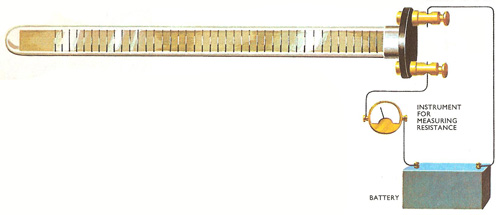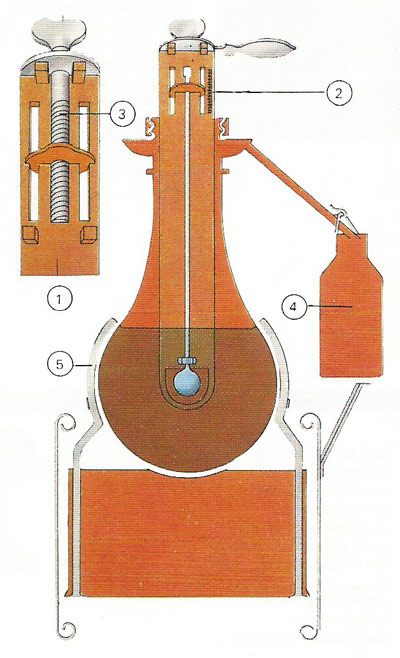thermometer

Figure 1. Clinical thermometer. When the bulb of the thermometer is placed under the tongue of the patient, the mercury in the bulb expands and forces a column of mercury of the scale tube. When the thermometer is removed for inspection, the mercury in the bulb contracts but that in the tube cannot cannot flow back past the neck: the reading thus stays the same. The thermometer is reset by centrifugal shaking.

Figure 2. Platinum resistance thermometer.

Figure 3. Deluc thermometer. An accurate thermometer invented in the 1760s by J. A. Deluc had a brass plate (1) that could be moved along a scale (2) by a screw (3), which acted like a micrometer to give precise readings. As the liquid inside became warmer, it expanded into the overflow vessel (4). The whole cumbersome device was supported in a carrier (5)
A thermometer is an instrument for measuring the temperature of a substance on some reproducible scale. Its operation depends upon a
regular relationship between temperature and the change in size of a substance
(as in the mercury-in-glass thermometer)
or in some other physical property (as in the platinum resistance thermometer).
The type of instrument used in a given application depends on the temperature
range and accuracy required.
Types of thermometer
Most people think of a thermometer as mercury in a glass tube, and indeed, since the normal range of temperatures we are likely to experience is extremely small, this is the kind in most general use. The clinical thermometer (Figure 1) is a modified form of the normal mercury thermometer. Since the variation of body temperature is so small, certainly no more than 10 or 15°F around the average (98.4°F), it is graduated only within these limits. There is a narrowing in the tube just above the reservoir so that the level of mercury will not fall immediately the thermometer has been removed from the patient to be read.The platinum resistance thermometer (Figure 2) consists of a length of fine platinum wire wound on a mica frame and enclosed in a protective glass tube. Temperatures are found by measuring the wire's electrical resistance (this increases as it temperature rises).
Deluc thermometer
The Deluc thermometer is an accurate thermometer invented in the 1760s by J. A. Deluc. It had a brass plate that could be moved along a scale by a screw, which acted like a micrometer to give precise readings. As the liquid inside became warmer, it expanded into the overflow vessel. The whole cumbersome device was supported in a carrier (Figure 3).


